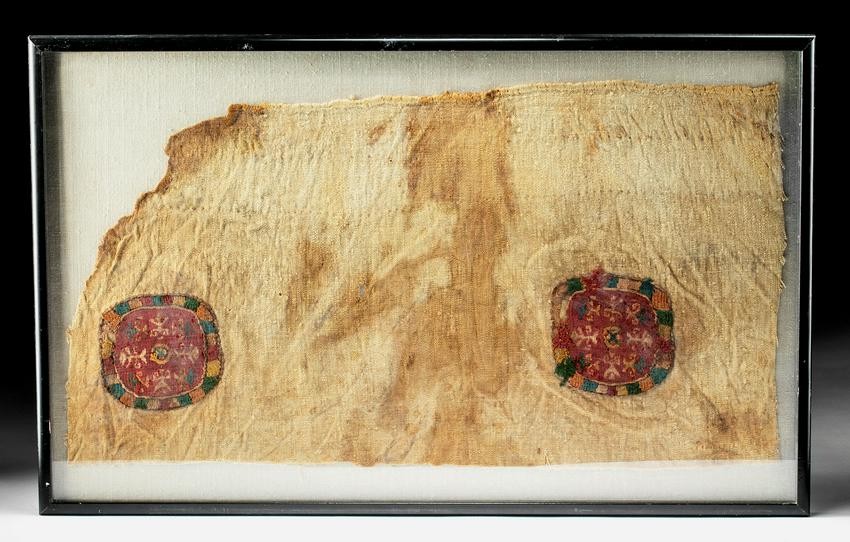Large Framed Egyptian Coptic Textile Burial Panel
**First Time At Auction**
Ancient Egypt, Coptic culture, ca. 4th to 5th century CE. A large and beautiful textile panel comprised of tightly woven fibers that form the larger beige panel. Each side of the linen is adorned with a separately-attached roundel that exhibits abstract anthropomorphic figures that seem to 'dance' around a central X-filled disc. Large textile panels were used to wrap the bodies of deceased individuals prior to burying them in the dry desert sands, and it is these same dry sands that have left this example in such a fine state of preservation. A rare and sizable example of ancient Coptic funerary traditions. Mounted inside a display frame. Size (textile): 28" W x 15" H (71.1 cm x 38.1 cm); (display frame): 30.125" W x 18.875" H (76.5 cm x 47.9 cm)
The Coptic culture of the ancient Near East were the Christian descendants of the ancient Egyptians. The emergence of Coptic art coincided with the decline of the Roman Empire and corresponded with the reemergence of native art in Egypt. Coptic weavers created masterpieces of textile art while utilizing intricate patterns and vivid colors. Coptic textiles were used for myriad purposes like rugs, wall hangings, and clothing appliques and were exported throughout the empires of Rome and Byzantium. However, burial wrappings like this example were made locally, usually by the family of the deceased. Coptic textiles are some of the only examples of ancient textiles to have survived since they have been preserved by the arid climate of the Egyptian deserts.
Provenance: private Vero Beach, Florida, USA collection, acquired in the 1970s at the Drouot Auction House, Paris, France; ex-private old French collection
All items legal to buy/sell under U.S. Statute covering cultural patrimony Code 2600, CHAPTER 14, and are guaranteed to be as described or your money back.
A Certificate of Authenticity will accompany all winning bids.
We ship worldwide to most countries and handle all shipping in-house for your convenience.
#153246
Condition Report: This is a fragment of a larger textile burial panel. Losses to areas of one corner as shown. Minor fraying and loosening to some interior and peripheral fibers, with likely reattachment of roundels to larger body panel, light fading to original pigmentation, and dark staining across several areas. Nice traces of original thread coloration on roundels. Display frame mounted with metal wire for suspension.
View it on
Estimate
Time, Location
Auction House
**First Time At Auction**
Ancient Egypt, Coptic culture, ca. 4th to 5th century CE. A large and beautiful textile panel comprised of tightly woven fibers that form the larger beige panel. Each side of the linen is adorned with a separately-attached roundel that exhibits abstract anthropomorphic figures that seem to 'dance' around a central X-filled disc. Large textile panels were used to wrap the bodies of deceased individuals prior to burying them in the dry desert sands, and it is these same dry sands that have left this example in such a fine state of preservation. A rare and sizable example of ancient Coptic funerary traditions. Mounted inside a display frame. Size (textile): 28" W x 15" H (71.1 cm x 38.1 cm); (display frame): 30.125" W x 18.875" H (76.5 cm x 47.9 cm)
The Coptic culture of the ancient Near East were the Christian descendants of the ancient Egyptians. The emergence of Coptic art coincided with the decline of the Roman Empire and corresponded with the reemergence of native art in Egypt. Coptic weavers created masterpieces of textile art while utilizing intricate patterns and vivid colors. Coptic textiles were used for myriad purposes like rugs, wall hangings, and clothing appliques and were exported throughout the empires of Rome and Byzantium. However, burial wrappings like this example were made locally, usually by the family of the deceased. Coptic textiles are some of the only examples of ancient textiles to have survived since they have been preserved by the arid climate of the Egyptian deserts.
Provenance: private Vero Beach, Florida, USA collection, acquired in the 1970s at the Drouot Auction House, Paris, France; ex-private old French collection
All items legal to buy/sell under U.S. Statute covering cultural patrimony Code 2600, CHAPTER 14, and are guaranteed to be as described or your money back.
A Certificate of Authenticity will accompany all winning bids.
We ship worldwide to most countries and handle all shipping in-house for your convenience.
#153246
Condition Report: This is a fragment of a larger textile burial panel. Losses to areas of one corner as shown. Minor fraying and loosening to some interior and peripheral fibers, with likely reattachment of roundels to larger body panel, light fading to original pigmentation, and dark staining across several areas. Nice traces of original thread coloration on roundels. Display frame mounted with metal wire for suspension.



